Mid-IR sensors — now more affordable, compact, and reliable — are making it possible to monitor and measure atmospheric gases in the field with remarkable sensitivity.
MICHAEL EISENSTEIN, SCIENCE WRITER
Mark Zondlo has an atmospheric chemistry laboratory at Princeton University, but you may have a hard time finding him there. Most of his team’s environmental research is conducted in the real world — roaming through America’s cornfields, rolling in high-tech cars through the world’s largest cities, and most recently, cruising miles above Earth’s surface. “We have a project with NASA where we’re putting an
ammonia-sensing instrument on the outside of the fuselage of a DC-8 to sample the atmosphere at 40,000 feet,” he said.
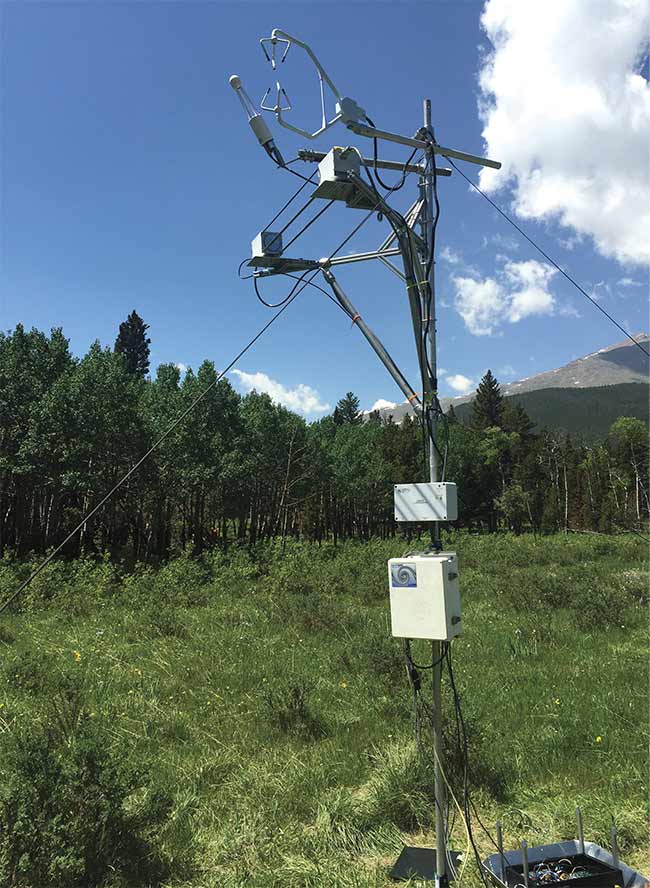
His group’s investigations of air quality and atmospheric indicators of climate change are enabled by mid-IR lasers, which operate in the 3- to 20-µm range of the spectrum. Such beams offer powerful tools for spectroscopic detection of diverse molecular targets in the atmosphere, including greenhouse gases and pollutants that may only be present at vanishingly small — but still environmentally significant — concentrations (Figure 1).
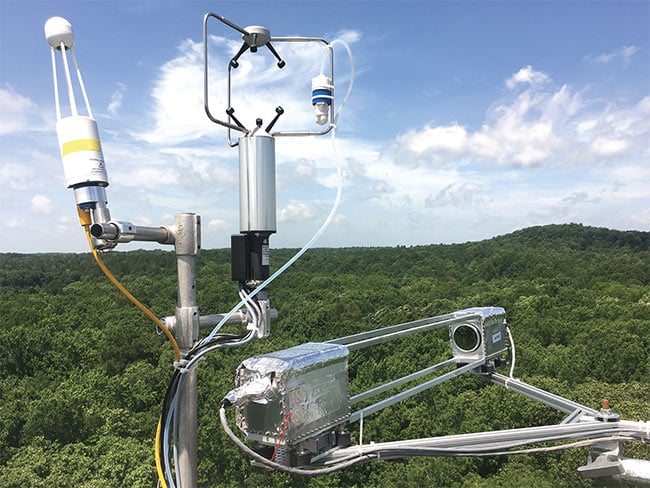
Figure 1. Mark Zondlo’s team is using sensitive mid-IR-laser-based detectors to measure ammonia and other environmentally important gases at field sites around the world. Courtesy of Da Pan.
“You have these atmospheric windows where you have transparency, and the water vapor is not interfering too much,” said Damien Weidmann of Rutherford Appleton Laboratory in the U.K. “This is the spectral region where the molecules of atmospheric interest interact the strongest with light.” But only in the past decade or so have scientists developed the tools to access these wavelengths effectively and affordably.
Quantum leap
When he first began working on mid-IR spectroscopy as a doctoral student in the late 1990s, Weidmann had to resort to cumbersome lead-salt lasers, which produced only weak beams and required cryogenic cooling. A few years earlier, in 1994, Bell Laboratories researchers including Federico Capasso and Jérôme Faist devised a promising alternative technology called the quantum cascade laser (QCL). These devices use multiple semiconductor layers, precisely arranged into structures so that multiple photons of the desired wavelength are emitted while electrons travel through the material. “You can start to optimize what precise wavelength window you need for a given problem,” Weidmann said, “and they can be tuned very fast, so you gain the potential for real-time analysis.”
Within a few years, a handful of manufacturers — such as Alpes Lasers SA, founded by Faist — were offering commercial QCLs. Researchers clamored for them, but the first-generation instruments were not exactly user-friendly. “It was this big device, about the size of half a loaf of bread,” Zondlo said. “And although they worked great in the lab at room temperature, the moment you stressed them and put them outside, thermal management became a problem.” This was a serious limitation, given that many of the most promising applications for these beams entailed deployment outdoors or in industrial settings.
Today, QCLs and mid-IR detectors have matured to a point where scientists can readily assemble the gas sensors needed for their research, alongside purpose-built commercial gas sensors intended for industrial use (Figure 2). “We are now achieving sensitivities of one part per billion for nitrous oxide, sulfur dioxide, and carbon dioxide with specialized instruments,” said Adam Piotrowski, president of detector manufacturer VIGO System SA. “And there are companies like Aerodyne that are even demonstrating parts-per-trillion sensitivity.” Prices are also plummeting. Zondlo said that whereas the first generation of bulky, cooled commercial lasers cost upward of $25,000, users can now purchase compact QCLs that operate at room temperature for around $5000.
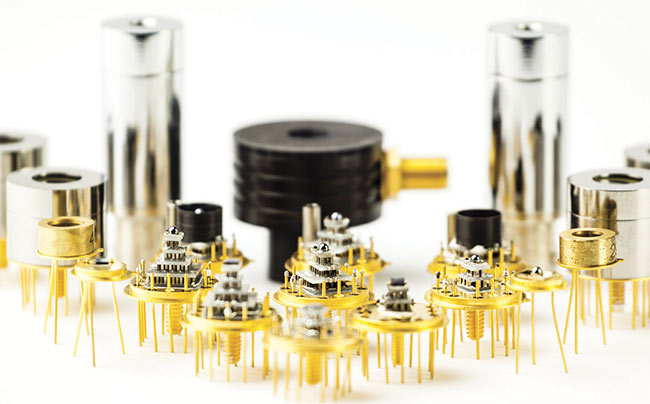
Figure 2. Poland-based VIGO System is scaling up production of mid-IR detectors in an effort to make atmospheric sensor systems more affordable and accessible. Courtesy of VIGO System SA.
A newer generation of mid-IR sources known as interband cascade lasers (ICLs) have also now reached commercial maturity. These are more energy-efficient and produce less heat than QCLs but also target a narrower range of the spectrum. However, this region encompasses many gases relevant to environmental and human health, including methane, carbon dioxide, and nitric oxide. “I’m focusing mostly on the region of 2 to 5 µm,” said Jana Jágerská, who is developing chip-based gas sensors at the Arctic University of Norway. “In this spectral region, ICLs are typically the number one choice for us, where we still have a good variety of materials for photonics, the detectors are relatively sensitive, and the light sources are not so power hungry.” However, only a few suppliers offer ICLs commercially, and some important gases, such as ammonia, are only detectable at longer wavelengths than these lasers can achieve.
Clearing the air
For both QCLs and ICLs, gas sensing is typically achieved with a technique called tunable diode laser absorption spectroscopy (TDLAS). This entails transmitting a beam tuned to the vibrational wavelength of the molecule of interest through a gas sample — for example, a 4.3-µm beam would be used to detect carbon dioxide. Individual molecules of carbon dioxide would absorb energy from this laser, with a sensitive detector analyzing
the outgoing beam to determine the concentration of this gas.
Zondlo performs his field studies using an open-path TDLAS configuration, where the beam is transmitted through the ambient environment rather than through a gas sample collected within an enclosed sensor cell. These open-path sensors are now sufficiently compact to mount in common passenger vehicles as mobile labs or atop slender towers situated in fields, swamps, or other environments. Zondlo’s team has used this approach to study methane emissions from the Marcellus Shale in Pennsylvania, a site where hydraulic fracturing is being used to extract natural gas, and to track greenhouse gas emissions in major metropolitan areas such as New York City and Beijing.
Mid-IR atmospheric sensing is fairly commonplace in the research world,
but it remains costly enough that commercial adoption is largely limited
to emissions monitoring in the petrochemical industry.
His current collaboration with NASA is part of an effort to monitor nitrogen-based gases released as a consequence of agricultural activity, including ammonia and nitrous oxide. “Nitrous oxide is the third most important greenhouse gas, with a lifetime of 130 years — so what goes into the atmosphere now is not coming out in my child’s lifetime, or his child’s lifetime,” Zondlo said. By understanding how factors such as fertilizer use affect gas emissions, it may become possible to develop more environmentally friendly and economical solutions for agriculture. Zondlo’s lab is one of many affiliated with Princeton’s center for Mid-Infrared Technologies for Health and the Environment (MIRTHE+), which was launched with support from the National Science Foundation in 2006 as a means to bring together experts in academia, industry, and government on the use of mid-IR sensing technology to solve global problems. For example, MIRTHE+ researchers spearheaded an effort to track air quality during the 2008 Olympics in Beijing.
Weidmann and colleagues have been making use of an alternative approach to mid-IR sensing known as laser dispersion spectroscopy (Figure 3). Rather than detecting absorption directly, this technique monitors changes in the refractive index of a gas sample that result from absorption events. Weidmann said this can result in less noise during detection, particularly when analyzing “dirty” samples that contain many other molecules besides the analyte of interest. “If you have aerosols in the way that cause power fluctuations, this will not affect your signal,” he said. In his academic work at Rutherford, he and his colleagues have used this strategy to investigate carbon gas release from volcanic sites.
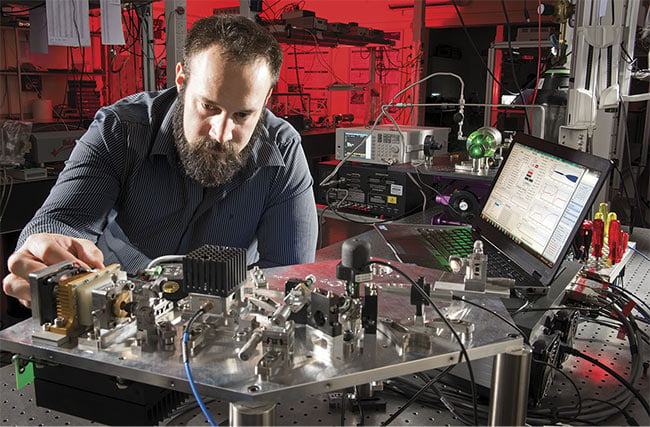
Figure 3. Nart Daghestani from Damien Weidmann’s group at the Rutherford Appleton Laboratory works with a prototype mid-IR gas sensor system. Courtesy of STFC.
They have also founded a company, MIRICO Ltd., to commercialize this technology in a family of sensor instruments. These are designed to detect gases, including methane and carbon dioxide, over distances of 50 to 500 m. “We’ve been monitoring greenhouse gases in areas like wetlands, landfills, and in the oil and gas industry, where understanding and monitoring methane emissions at a facility level is really important,” Weidmann said. The company is also working with the EU Science for Clean Energy consortium to study the atmospheric impacts of energy production and environmental remediation efforts.
Building a better beam
Mid-IR atmospheric sensing is fairly commonplace in the research world, but it remains costly enough that commercial adoption is largely limited to emissions monitoring in the petrochemical industry. Jágerská said much of the commercial investment in IR lasers to date has focused on the near-IR spectral range used in the telecommunications industry. “They spent years and a lot of effort to minimize the losses of optical fibers until they reached the current performance,” she said. “The materials for mid-IR are not so mature.”
However, programs like MIRTHE+ are helping to accelerate commercialization. According to Zondlo, “There has been a lot of feedback between companies and academic and government researchers in the mid-IR photonics and QCL space about what are the pain points.” And in Europe, the multinational MIRPHAB (MIR photonics devices fabrication for chemical sensing and spectroscopic applications) consortium is bringing together expertise from leading commercial players in the space to enable rapid prototyping and deployment of mid-IR technologies.
VIGO, which is part of both MIRTHE+
and MIRPHAB, is actively scaling up manufacturing in anticipation of broader adoption, according to Piotrowski. “Last year, we finalized investment into an assembly building where we can accommodate production starting from 100,000 detectors per year,” he said. “Our goal is to make our components cheaper and ready for the consumer market.”
Meanwhile, researchers continue to push the capabilities of the technology.
Miniaturization is a top priority, and Jágerská is among those working on shrinking mid-IR gas sensors down to microchip scale (Figure 4). One key challenge here is that sensor sensitivity is proportional to the distance traveled by the laser, and her team is developing waveguides that can replicate this effect at the centimeter scale. “We want to fold this long optical path length, which is realized in free space in a typical instrument, within cells which have nanoliters of sample volume on a tiny chip,” she said.
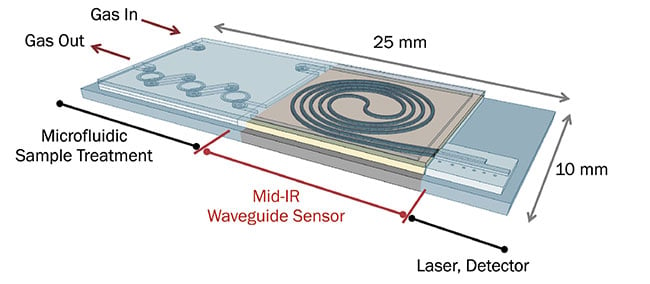
Figure 4. Jana Jágerská’s team is developing tiny microchip-based mid-IR systems that could be used in sensor hardware for space missions or to achieve sensitive gas detection in medical devices. Courtesy of Susanne Lagerström.
Jágerská is looking to use these shrunken sensors to study how bacteria in the permafrost metabolize gases such as methane and carbon dioxide, and how the effects of rising global temperatures may affect levels of these gases. Similar chips could also prove invaluable for space missions, or even as medical devices that analyze the gas content of patients’ breath.
For the present, Zondlo is most enthusiastic about the potential for using the existing mid-IR toolbox to perform similar “breath sensing” for the world’s cities — studying the dynamic shifts in various atmospheric gases to understand factors influencing their production. “QCLs and ICLs and commercial instruments could be a new way for studying greenhouse gases and carbon footprint mitigation of cities at a regional scale,” he said. “That doesn’t exist right now.”
Acknowledgments
The author would like to thank Mark Zondlo of Princeton University, Damien Weidmann of the Rutherford Appleton Laboratory and MIRICO, Adam Piotrowski of VIGO System SA, and Jana Jágerská of the Arctic University of Norway.